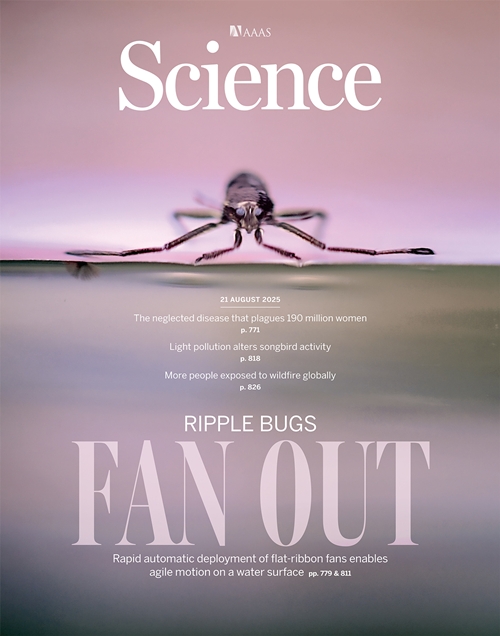
A research team led by Koh Je-Sung, a professor of mechanical engineering at Ajou University in Suwon, Gyeonggi-do Province, has identified the movement mechanism of ripple bugs (rhagovelia) and developed an uber-small robot based on this. This study made the cover of the Aug. 21 edition of the academic journal Science. (Science)
By Margareth Theresia
A Korea-led research team has discovered the agility principles of ripple bugs to develop the world's first uber-small aquatic robot to mimic such movement.
The Ministry of Science and ICT on Aug. 22 said the team led by Koh Je-Sung, a professor of mechanical engineering at Ajou University, jointly conducted the study with researchers at the University of California-Berkeley and Georgia Institute of Technology of the U.S.. They found the movement mechanisms of ripple bugs (rhagovelia), which move freely on the surface water, to develop the robot.
The research was highlighted on Aug. 21 as a cover story of the global journal Science.
The news site Science X said in an article, "Finally, these discoveries could have wide-ranging implications for bioinspired robotics, particularly in the development of environmental monitoring systems, search-and-rescue microrobots, and devices capable of navigating perturbed water-air interfaces with insect-like dexterity."
Rhagovelia, an aquatic insect that belongs to the family Veliidae, is known for strong propulsion and outstanding mobility even in fast-moving water thanks to the fan-shaped structure at the end of its hind legs. How this structure works in principle in such a short time, however, had not been scientifically confirmed.
The team discovered that the ripple bug's fan structure works automatically through interaction with the underwater environment, not muscular contractions. The structure opens within a hundredth of a second after the bug's legs are submerged in water and retracts nearly immediately after resurfacing, showing an ultra-fast self-transformation mechanism.
Based on this principle, the researchers designed a tiny robot that accurately imitates the fan structure of a ripple bug and used 21 string-like artificial hairs. Despite its small insect-like size, the gadget showed strong propulsion on water and the ability to agilely change direction.
Ko said, "We will identify the structural intelligence of insects in nature for use in fields such as environmental monitoring, rescue operations and biomimetic robotics."
margareth@korea.kr